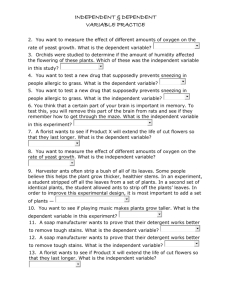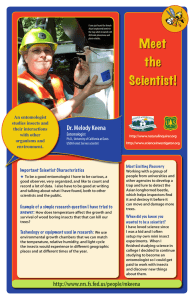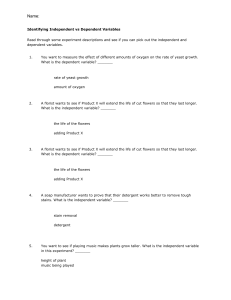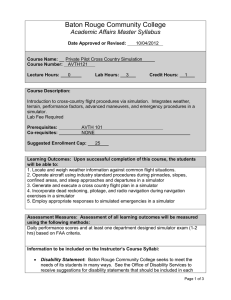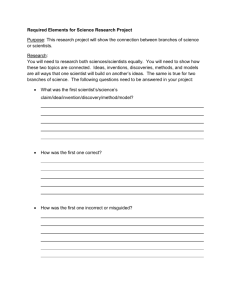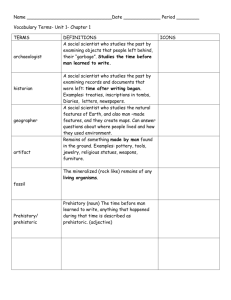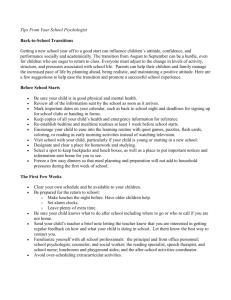Ch 1 SG- 2014
advertisement
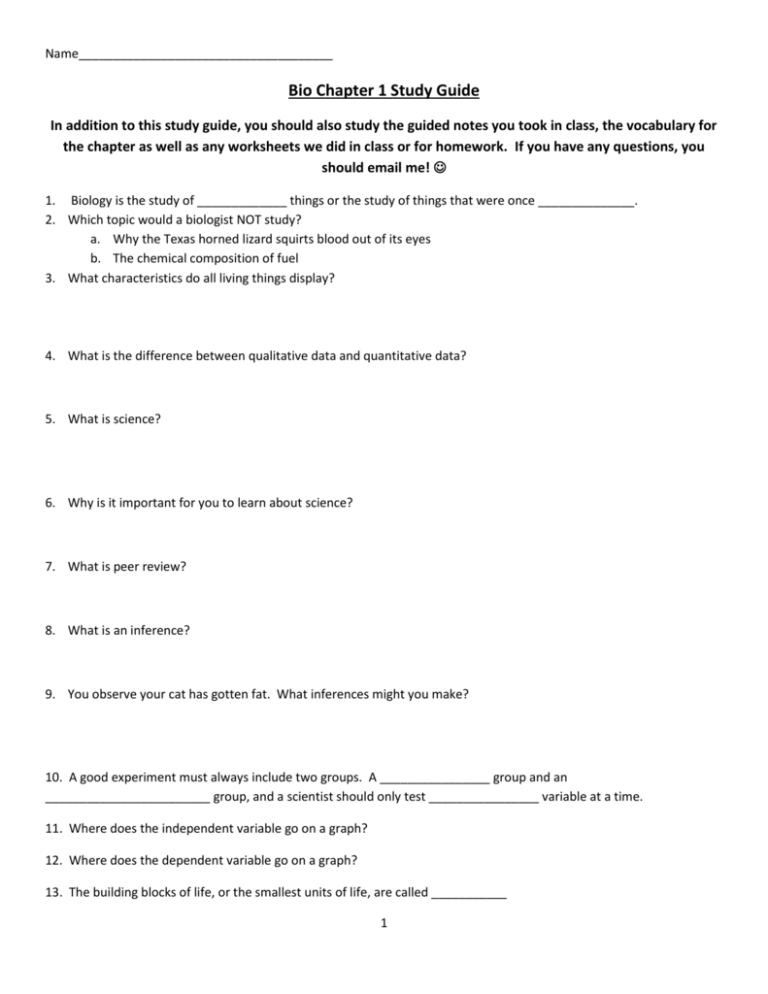
Name_____________________________________ Bio Chapter 1 Study Guide In addition to this study guide, you should also study the guided notes you took in class, the vocabulary for the chapter as well as any worksheets we did in class or for homework. If you have any questions, you should email me! 1. Biology is the study of _____________ things or the study of things that were once ______________. 2. Which topic would a biologist NOT study? a. Why the Texas horned lizard squirts blood out of its eyes b. The chemical composition of fuel 3. What characteristics do all living things display? 4. What is the difference between qualitative data and quantitative data? 5. What is science? 6. Why is it important for you to learn about science? 7. What is peer review? 8. What is an inference? 9. You observe your cat has gotten fat. What inferences might you make? 10. A good experiment must always include two groups. A ________________ group and an ________________________ group, and a scientist should only test ________________ variable at a time. 11. Where does the independent variable go on a graph? 12. Where does the dependent variable go on a graph? 13. The building blocks of life, or the smallest units of life, are called ___________ 1 Name_____________________________________ 14. When doing an experiment, what you measure is called the _____________________ variable. What you, as the scientist, control is the __________________________ variable. 15. An entomologist (bug scientist) wants to determine whether temperature affects the number times a cricket chirps. What is the dependent variable? 16. You want to test a new drug that supposedly prevents sneezing in people allergic to grass. What is the independent variable? 17. You want to measure the effect of different amounts of oxygen on the rate of yeast growth. What is the independent variable? 18. You think that a certain part of your brain is important in memory. To test this, you will remove this part of the brain from rats and see if they remember how to get through the maze. What is the independent variable in this experiment? 19. An entomologist (bug scientist) wants to determine if temperature affects the number of times a cricket chirps. What is the independent variable? 20. A florist wants to see if Product X will extend the life of cut flowers so that they last longer. What is the dependent variable? 21. You think that a certain part of your brain is important in memory. To test this, you will remove this part of the brain from rats and see if they remember how to get through the maze. What is the dependent variable in this experiment? 22. You want to see if playing music makes plants grow taller. What is the dependent variable in this experiment? 23. Orchids were studied to determine if humidity affects the flowering of these plants. Which of these was the independent variable in this study? 24. A soap manufacturer wants to prove that their detergent works better to remove tough stains. What is the dependent variable? 25. You want to test a new drug that supposedly prevents sneezing in people allergic to grass. What is the dependent variable? 26. A florist wants to see if Product X will extend the life of cut flowers so that they last longer. What is the independent variable? 27. You want to see if playing music makes plants grow taller. What is the independent variable in this experiment? 28. A soap manufacturer wants to prove that their detergent works better to remove tough stains. What is the independent variable? 2 Name_____________________________________ In your textbook, read about the characteristics of life in Chapter 1 (pgs. 4-21). Refer to the diagrams. Respond to each statement. A. Flame B. Euglena C. Fish 29. List any image that depicts a living thing. 30. Explain why any image you did not list does not depict a living thing. Read each of the following items. If it describes a living thing, write yes. If not, write no. 31. is made of one or more cells…____________________ 32. cannot respond to its environment…________________ 33. requires energy to function…____________________ Number the levels of the organization of living things from 1 through 6. Put them in order from simplest to most complex. ___34. organs ___36. organism ___38. organ system ___ ___37. tissues ___39. biosphere 35. cell For each statement, circle the stimulus and underline the response. 40. Your mouth waters at the sight of food on a plate. 41. There is a sudden drop in air temperature, which gives you goose bumps. 42. You get a fever after a virus enters your body. 43. You get "butterflies" in your stomach before giving a speech. Refer to the graph. Respond to the following statement. 3 Name_____________________________________ 44. Name the process that the graph represents. Describe this process. Read the following scenarios. For each, indicate the independent variable, dependent variable, experimental group, and control group: 45. A group of college students were given a short course in speed-reading. The instructor was curious if a monetary incentive would influence performance on a reading test taken at the end of the course. Half the students were offered $5 for obtaining a certain level of performance on the test, the other half were not offered money. Independent variable: Dependent variable: Experimental group: Control group: 46. A social psychologist thinks that people are more likely to conform to a large crowd than to a single person. To test this hypothesis, the social psychologist had either one person or five persons stand on a busy walking path on campus and look up. The psychologist stood nearby and counted the number of people passing by who also looked up. Independent variable: Dependent variable: Experimental group: Control group: 47. To test a new voice feature in a cockpit design a flight simulator was used. The simulator was programmed to give visual readings of flight information, or to give visual and auditory (voice) readings of flight information. All test pilots were put through a simulated emergency landing procedure, but were randomly assigned to the visual, or visual and auditory conditions. Flight experts rated each pilot’s performance in the simulator on a scale of 1 (very poor) to 10 (excellent). Independent variable: Dependent variable: Experimental group: Control group: 4
